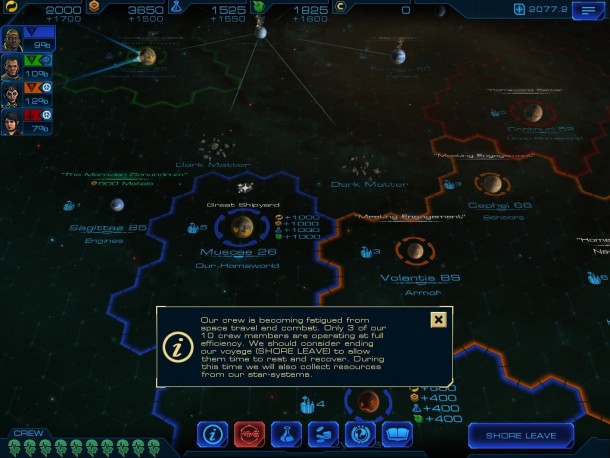Sid Meier’s Starships Review
"This would be good as a mobile game" was, historically, some pretty faint praise. A sort of euphemism for alleging that a game was baser somehow, that in exchange for a shallow, compulsive high it asked little of a player save the odd microtransaction. Drag a distracted finger across a screen a few times, and kill, conquer, level up…all between stops on the train. I don't cotton to those implications, not anymore: Mobile games have achieved too much, broken too many molds. But in some circles you can still hear the old backhanded compliment being leveled at games like Sid Meier's Starships.
Starships happens to actually be a mobile game--the kind that harks to those days of yore, when "mobile" equated to "simplistic." It released simultaneously on PC, Mac, and iPad, and in more-or-less the same form to boot. And the first things you notice about it are the various ways it seems visually bottlenecked by its tablet version. On PC, it unfurls in a tablet's compacted, low resolution window, and there are no graphical settings to massage. Its sci-fi galaxy is mostly abstracted, and its unit models are simple and blocky. It's not those issues that really put me off of Starships, but rather the way it seems to aspire to that narrow, dated idea of what makes a "good" mobile game. I can turn aside the quick and obvious assaults on PC sensibilities--the rough graphics, the lack of options--but it's the cynical design that guts me, in the end.
The titular starships form a single roving fleet on the game's galactic map, and act as the lone controllable unit. From your home base, the fleet can be moved over to any adjacent planet with the press of a button, which triggers combat missions that award points towards bringing the planet into the fold of your empire. Planets under your control confer resources each turn (food, industrial production, science, and energy) that can be spent on upgrades for your starships, or used towards buildings and world wonders that improve your production or military capabilities. The salient goal is to have a majority of the galaxy under your thumb--51%, and no less.
Where Meier's Civilization series accommodates pacifism, there isn't much to do with your Starships fleet on the galactic map except pick fights. There are victory conditions outside of conquering your opponents, sure--controlling X amount of world wonders or researching Y amount of technologies--but these goals take resources to complete, and the only way to fill your storehouses is to perform combat missions and claim planets. The different victories have different names, but they all boil down to exercising military might, which in turn requires trudging through watered down and grossly exploitable battles.
Combat missions set your ships down on a honeycomb game space surrounding a planet. You might be asked to escort a unit (that, mercifully, you also control), or hunt down an escorted one yourself. Or you navigate a maze of asteroids to reach an escape gate, or defeat an enemy boss. The asteroids strewn about the playing field block fire, and black holes teleport ships to other black holes on the map. It's simplistic board game strategy propped up by only the barest of fiction, and eminently exploitable. Every one of your ships can be upgraded to deploy zippy, surprisingly powerful fighters, meaning that in a single turn it's possible to effectively double the size of your fleet. The fighters are fragile, but they're so strong and can quickly cover so much distance that they throw the balance of any fight. Even forgoing them, I found I was able to comfortably win almost every engagement on any difficulty level by committing to longer range lasers and picking off enemies as they tried to approach, one at a time. It's a strategy game without strategy, enabling you to sleepwalk your way to triumph.

Starships ostensibly picks things up where Civilization: Beyond Earth left off, but practically speaking, all that means is that the preceding game's cardboard cutout leaders have been stood in front of Starship's backgrounds. Each has a unique stat bonus in place of an actual personality, and their speech is characteristically mechanistic. "Our computer calculations indicate that you have but a 19% chance of dominating this galaxy" is what passes for a greeting in the game's stripped-down version of diplomacy. If you're thinking about declaring war after that (and I wouldn't blame you if you were), it's trivially easy to gauge your odds. Your opponents themselves provide an itemized list of their military assets on request--Starships is wanting for any other, more suitable screen to house the information. There are no ceremonial trappings, here. Two deadpan leaders simply meet, compare spreadsheets, and arrange peace or war accordingly.
You're presented with a similar rundown at the end of missions, tabulating all the ships destroyed and lost, and divvying out bonuses multiplied by various modifiers. Starships throws these figures and calculations at you, but there's nothing useful to be done with the information, as though the game just wants to make sure you know that it did the work. Numbers are always going up a thousand at a time in the game--you get lost in all that effortless forward momentum, and it becomes impossible to care about a few lost hundred here or there.
Beyond Earth's Affinities also make the jump, representing a choice between one of three broad societal values: Purity, Supremacy, or Harmony. But like everything in Starships, they've come unmoored from any cultural tie-downs, and now simply denote which of three arbitrary stat bonuses you feel like beginning the game with. Constructing a wonder means pressing a button when you've got enough of the requisite resource. There's no actual sense of building--a variable has simply shifted somewhere behind the scenes. It's an issue exacerbated by the fact that your ships are functionally immortal--though they appear to blow apart when destroyed in battle, you can still simply repair them afterward for a nominal cost. Even the loss of an entire fleet in a mission simply means being sent back to the planet you arrived from, down a few of the action points you expend to move around on the map on a turn. The stakes of this intragalactic war are at mechanical remove--any one defeat amounts only to an obscure amount of wasted man-hours.

As mobile games find new heights, Starships takes its sci-fi premise and uses it to trawl the primordial pools they ascended from. Its planets are suspended in a two dimensional plane, and when your turn is up, enemy fleets dart back and forth among them in seemingly random directions. They look less like interstellar armadas, and more like single celled organisms responding to simple stimuli. They flit about from planet to planet, hex cell to cell, as though guided by the basest biological compulsions, consuming and growing. And you're right alongside them--with a few disinterested clicks or swipes across the screen, killing, conquering, and leveling up.









